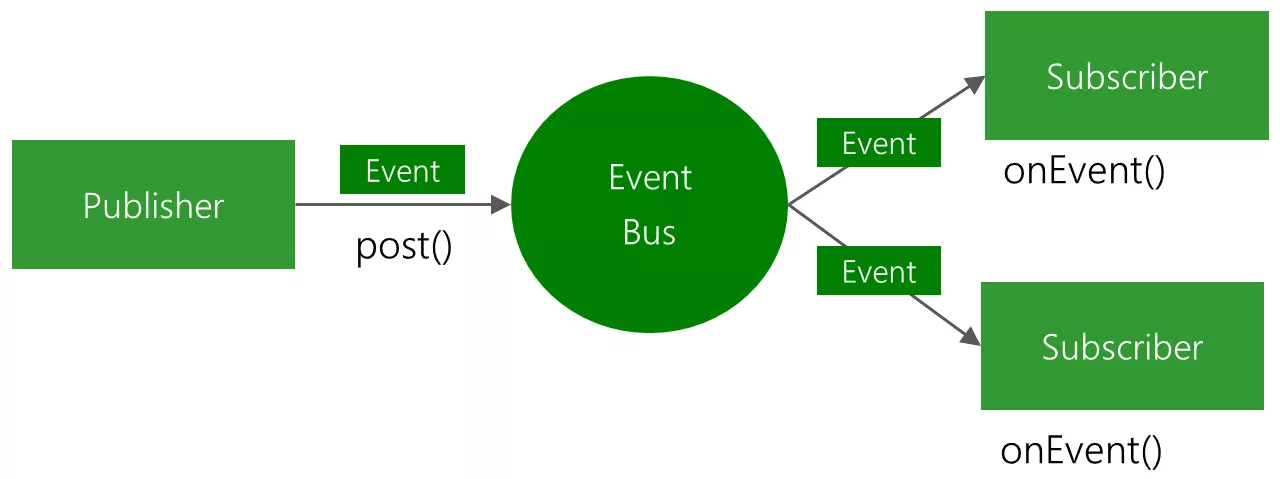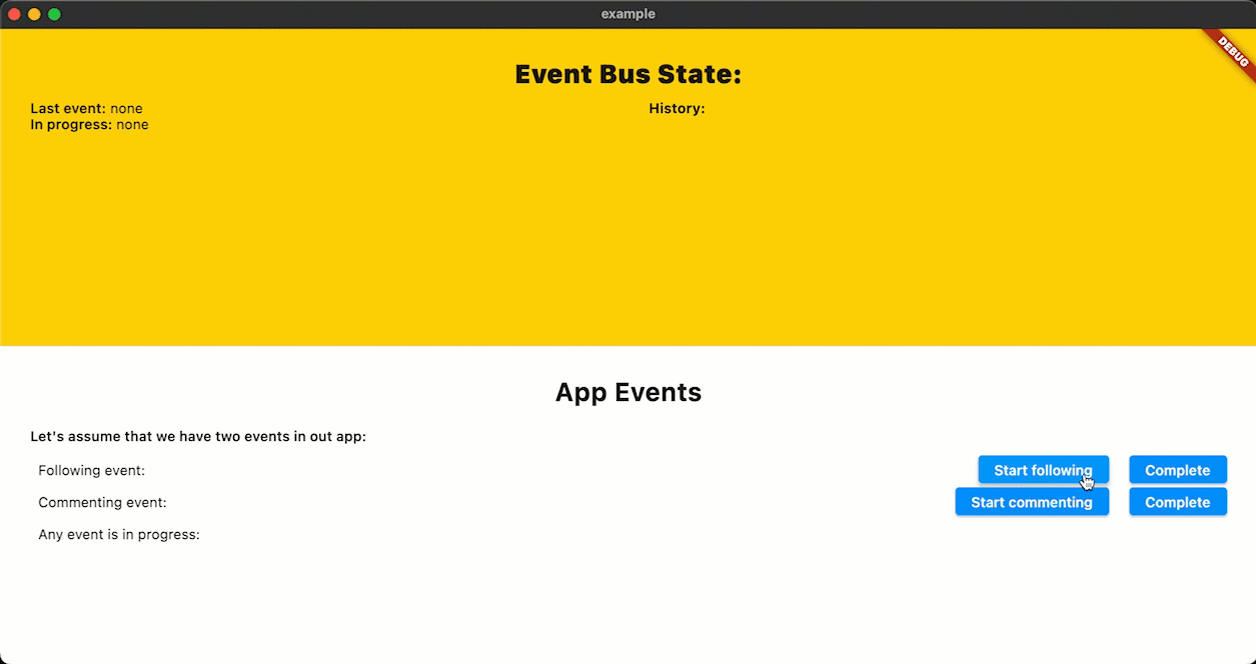Flutter事件总线插件event_bus_plus的使用
Flutter事件总线插件event_bus_plus的使用
EventBus: Events for Dart/Flutter
描述
EventBus 是一个开源库,它为Dart和Flutter提供了基于发布/订阅模式的松耦合通信。通过EventBus,你可以用几行代码实现组件之间的集中式通信,简化代码结构,减少依赖关系,并加速应用程序开发。

使用EventBus的好处
- 简化组件间的通信;
- 解耦事件发送者和接收者;
- 在UI组件(如Widgets, Controllers)中表现良好;
- 避免复杂的、容易出错的依赖关系和生命周期问题。

定义应用事件
// 初始化服务总线
IAppEventBus eventBus = AppEventBus();
// 定义应用事件
final followEvent = FollowEvent('@devcraft.ninja');
final commentEvent = CommentEvent('Awesome package 😎');
订阅事件
// 监听最新事件
final sub = eventBus.last$.listen((AppEvent event) {
// do something
});
// 监听特定类型的事件
final sub2 = eventBus.on<FollowAppEvent>().listen((e) {
// do something
});
发布事件
// 触发事件
eventBus.fire(followEvent);
监视进行中的事件
// 开始监视事件直到完成
eventBus.watch(followEvent);
// 检查进度
eventBus.isInProgress<FollowAppEvent>();
// 或监听流以检查处理状态
eventBus.inProgress$.map((List<AppEvent> events) =>
events.whereType<FollowAppEvent>().isNotEmpty);
// 完成事件
eventBus.complete(followEvent);
// 或使用完成事件完成
eventBus.complete(followEvent, nextEvent: SomeAnotherEvent());
查看历史记录
final events = eventBus.history;
映射
final eventBus = bus = EventBus(
map: {
SomeEvent: [
(e) => SomeAnotherEvent(),
],
},
);
示例代码
以下是event_bus_plus的一个完整示例demo:
import 'package:event_bus_plus/event_bus_plus.dart';
import 'package:flutter/material.dart';
// 初始化服务总线
IEventBus eventBus = EventBus();
void main() {
// 监听所有事件
eventBus.on().listen((event) {
print('${DateTime.now()} Event: $event');
});
runApp(MyApp());
}
class MyApp extends StatelessWidget {
const MyApp({Key? key}) : super(key: key);
@override
Widget build(BuildContext context) {
return MaterialApp(
title: 'EventBus Demo',
theme: ThemeData(
primarySwatch: Colors.blue,
),
home: MyHomePage(title: 'EventBus Demo Home Page'),
);
}
}
class MyHomePage extends StatefulWidget {
const MyHomePage({Key? key, required this.title}) : super(key: key);
final String title;
@override
State<MyHomePage> createState() => _MyHomePageState();
}
class _MyHomePageState extends State<MyHomePage> {
int _counter = 0;
void _incrementCounter() {
setState(() {
_counter++;
});
// 发布一个计数器增加的事件
eventBus.fire(CounterIncreasedEvent(_counter));
}
@override
Widget build(BuildContext context) {
return Scaffold(
appBar: AppBar(
title: Text(widget.title),
),
body: Center(
child: Column(
mainAxisAlignment: MainAxisAlignment.center,
children: <Widget>[
const Text(
'You have pushed the button this many times:',
),
Text(
'$_counter',
style: Theme.of(context).textTheme.headline4,
),
],
),
),
floatingActionButton: FloatingActionButton(
onPressed: _incrementCounter,
tooltip: 'Increment',
child: const Icon(Icons.add),
),
);
}
}
// 定义一个简单的计数器增加事件
class CounterIncreasedEvent {
final int count;
CounterIncreasedEvent(this.count);
@override
String toString() {
return 'CounterIncreasedEvent{count: $count}';
}
}
在上面的例子中,我们创建了一个简单的Flutter应用,当用户点击FloatingActionButton时,会触发计数器增加的事件。这个事件会被eventBus捕获并打印出来。
希望这些信息对您有帮助!如果您有任何疑问或需要进一步的帮助,请随时提问。
更多关于Flutter事件总线插件event_bus_plus的使用的实战教程也可以访问 https://www.itying.com/category-92-b0.html
更多关于Flutter事件总线插件event_bus_plus的使用的实战系列教程也可以访问 https://www.itying.com/category-92-b0.html
当然,以下是如何在Flutter项目中使用event_bus_plus插件的一个简单示例。event_bus_plus是一个事件总线库,允许你在应用的不同部分之间发送和接收事件。这对于实现状态管理非常有用,尤其是在不需要复杂状态管理库(如Provider、Riverpod或Bloc)的简单场景下。
1. 添加依赖
首先,在你的pubspec.yaml文件中添加event_bus_plus依赖:
dependencies:
flutter:
sdk: flutter
event_bus_plus: ^2.0.0 # 请检查最新版本号
然后运行flutter pub get来获取依赖。
2. 定义事件类
创建一个简单的事件类。这个类可以是任何实现了Event接口的类,但在event_bus_plus中,你通常不需要显式实现任何接口。
class CounterEvent {
final int count;
CounterEvent({required this.count});
}
3. 初始化EventBus
在你的应用中的某个地方(比如main.dart或者一个全局的provider文件中)初始化EventBus实例。
import 'package:event_bus_plus/event_bus_plus.dart';
import 'counter_event.dart'; // 假设你的事件类定义在这个文件中
final EventBus eventBus = EventBus();
4. 发送事件
在你想发送事件的地方使用eventBus.fire方法。
import 'package:flutter/material.dart';
import 'counter_event.dart';
import 'main.dart'; // 导入eventBus实例
void _incrementCounter() {
// 这里我们假设有一个计数器状态,我们增加它并发送一个事件
int count = 0; // 假设这是你的计数器状态
count++;
eventBus.fire(CounterEvent(count: count));
}
5. 订阅事件
在你想监听事件的地方使用eventBus.on<EventType>().listen方法。
import 'package:flutter/material.dart';
import 'counter_event.dart';
import 'main.dart'; // 导入eventBus实例
class CounterScreen extends StatefulWidget {
@override
_CounterScreenState createState() => _CounterScreenState();
}
class _CounterScreenState extends State<CounterScreen> {
int _count = 0;
@override
void initState() {
super.initState();
// 订阅CounterEvent事件
eventBus.on<CounterEvent>().listen((event) {
setState(() {
_count = event.count;
});
});
}
@override
void dispose() {
// 取消订阅以避免内存泄漏
eventBus.off<CounterEvent>();
super.dispose();
}
@override
Widget build(BuildContext context) {
return Scaffold(
appBar: AppBar(
title: Text('Counter'),
),
body: Center(
child: Column(
mainAxisAlignment: MainAxisAlignment.center,
children: <Widget>[
Text(
'You have pushed the button this many times:',
),
Text(
'$_count',
style: Theme.of(context).textTheme.headline4,
),
],
),
),
floatingActionButton: FloatingActionButton(
onPressed: _incrementCounter,
tooltip: 'Increment',
child: Icon(Icons.add),
), // This trailing comma makes auto-formatting nicer for build methods.
);
}
}
总结
以上代码展示了如何在Flutter项目中使用event_bus_plus插件来实现事件总线机制。通过定义事件类、初始化EventBus、发送事件和订阅事件,你可以轻松地在应用的不同部分之间传递数据。这种方法对于简单的状态管理非常有效,但在处理更复杂的状态管理需求时,可能需要考虑使用更强大的状态管理库。







